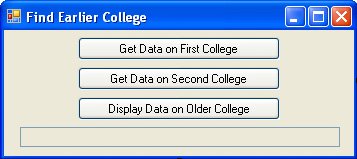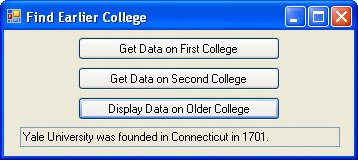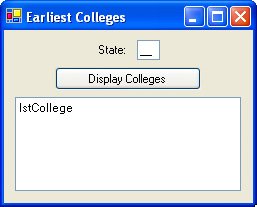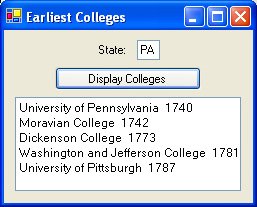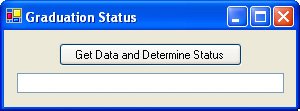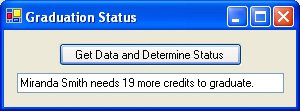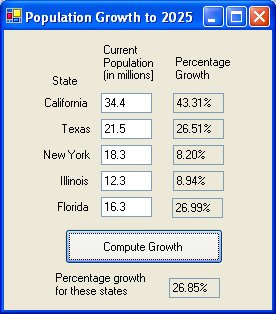Section 7.3. Some Additional Types of Arrays
7.3. Some Additional Types of ArraysSo far, the array elements have been standard data types. This section considers arrays of controls and arrays of a new compound data type designed by the programmer. Control ArraysWe have seen many examples of the usefulness of subscripted variables. They are essential for writing concise solutions to many programming problems. Because of the utility that subscripts provide, Visual Basic also provides for arrays of labels, text boxes, and buttons. Since labels, text boxes, and buttons are referred to generically in Visual Basic as controls, arrays of these objects (or of any other control) are called control arrays. Note:Since Visual Basic does not provide for arrays of masked text boxes, we will only use ordinary text boxes for input. Control arrays are created in much the same way as any other array; that is, with a statement of the form Dim arrayName(n) As ControlTypeor Dim arrayName() As ControlTypeFor instance, the following statements declare control arrays. Dim lblTitle(10) As Label Dim txtNumber(8) As TextBox Dim btnAmount() As ButtonExample 1. | |||||||||||||||||||||||||||||||||||||||||||||||||||||||||||||||||||||||||||||||||||||||||||||||||||||||||||||||||||||||||||||||||||||||||||||||||||||||||||||||||||||||||||||||||||||||||||||||||||||||||||||||||
| A department store has five departments. The following program requests the amount of sales for each department and displays the total sales for the store. The five labels identifying the departments are grouped into an array of labels and the five text boxes for the individual amounts are grouped into an array of text boxes. The initial settings for these labels are specified at run time in the frmSales_Load event procedure instead of being specified at design time. The Text properties of the labels are set to be "Department 1", "Department 2", and so on.
Dim lblDept(4) As Label DimtxtDept(4)As TextBox Private Sub frmSales_Load(...) Handles MyBase. Load lblDept(0) = Label1 lblDept(1) = Label2 lblDept(2) = Label3 lblDept(3) = Label4 lblDept(4) = Label5 txtDept(0) = TextBox1 txtDept(1) = TextBox2 txtDept(2) = TextBox3 txtDept(3) = TextBox4 txtDept(4) = TextBox5 'Set the labels' Text property to the corresponding department 'Set the text boxes' Text property to the empty string For depNum As Integer = 1 To 5 lblDept(depNum - 1).Text = "Department " & depNum & ":" Next End Sub Private Sub btnCompute_Click(...) Handles btnCompute.Click Dim totalSales As Double = 0 For depNum As Integer = 1 To 5 totalSales += CDbl(txtDept(depNum - 1).Text) Next txtTotal.Text = FormatCurrency(totalSales) End Sub [Run, enter amounts into the text boxes, and then click the button.] |
Structures
Some of the data types we have worked with so far are Double, Integer, String, and Boolean. A structure provides a convenient way of packaging as a single unit several related variables of different types. In previous versions of Visual Basic a structure was called a user-defined type (UDT).
Three pieces of related information about colleges are "name," "state," and "year founded." A structure type capable of holding this data is defined by the following block of statements located in the Declarations section of the Code window.
Structure College Dim name As String Dim state As String Dim yearFounded As Integer End StructureEach of the three subvariables of the structure type is called a member. A structure variable of the type College is declared by a statement such as
Dim college1 As CollegeEach member is accessed by giving the name of the structure variable and the member, separated by a period. For instance, the three members of the structure variable college1 are accessed as college1.name, college1.state, and college1.yearFounded.
In general, a structure type is defined by a Structure block of the form
Structure StructureType Dim memberName1 As MemberType1 Dim membername2 As MemberType2 . . . End Structurewhere StructureType is the name of the user-defined data type; memberName1, memberName2,..., are the names of the members of the structure; and MemberType1, MemberType2,..., are the corresponding member types, such as String, Integer, Double, or Boolean.
A structure variable, structureVar, is declared to be of the user-defined type by a statement of the form
Dim structureVar As StructureTypeExample 2. (This item is displayed on pages 344 - 345 in the print version)
| The following program stores information about two colleges into structure variables of type College and uses the variables to determine which college is older. Note: In the third line of the btnOlder_Click event procedure, all the member values of college1 are assigned simultaneously to collegeOlder.
Structure College Dim name As String Dim state As String Dim yearFounded As Integer End Structure Dim college1, college2, collegeOlder As College Private Sub btnFirst_Click(...) Handles btnFirst.Click Dim prompt As String college1.name = InputBox("Enter name of first college.", "Name") college1.state = InputBox("Enter state of first college.", "State") prompt = "Enter the year the first college was founded." college1.yearFounded = CInt(InputBox(prompt, "Year")) End Sub Private Sub btnSecond_Click(...) Handles btnSecond.Click Dim prompt As String college2.name = InputBox("Enter name of second college.", "Name") college2.state = InputBox("Enter state of second college.", "State") prompt = "Enter the year the second college was founded." college2.yearFounded = CInt(InputBox(prompt, "Year")) End Sub Private Sub btnOlder_Click(...) Handles btnOlder.Click If (college1.yearFounded < college2.yearFounded) Then collegeOlder = college1 Else collegeOlder = college2 End If txtResult.Text = collegeOlder.name & " was founded in " & _ collegeOlder.state & " in " & collegeOlder.yearFounded & "." End Sub [Run, click the first button, and respond to the input boxes with Princeton University, New Jersey, 1746. Click the second button; respond to the input boxes with Yale University, Connecticut, 1701. Finally, click the third button.] |
Example 3. (This item is displayed on pages 345 - 346 in the print version)
| The file COLLEGES.TXT holds the name, state, and year founded for each of the 27 colleges in the United States founded before 1800. The first three lines of the file contain the data Harvard University, MA, 1636. The following program places the information about the colleges into an array of structures. The array is then used to display the names of the colleges in a specified state. Note: The masked text box has Mask "LL". Structure College Dim nameAs String Dim state As String Dim yearFounded As Integer End Structure Dim school(26) As College Private Sub frmColleges_Load(...) HandlesMyBase.Load 'Place the data for each college into the array school() Dim i As Integer = - 1 Dim sr As IO.StreamReader = IO.File.OpenText("COLLEGES.TXT") Do While (sr.Peek <> - 1) i += 1 school(i).name = sr.ReadLine [Run, type the name of a state into the masked text box, and click the button.] |
So far, the members of structures have had elementary types; such as String or Integer. However, the type for a member can be another structure or an array type. When a member is given an array type, the defining Dim statement must not specify the upper bound; this task must be left to a ReDim statement. Example 4 demonstrates the use of both of these nonelementary types of members. In addition, the example shows how to pass a structure variable to a Sub procedure.
Example 4. (This item is displayed on pages 346 - 347 in the print version)
| The following program totals a person's college credits and determines whether they have enough credits for graduation. Notes: The structure variable person is local to the btnGet_Click event procedure. In the fourth line of the procedure, person.name.firstName should be thought of as (person.name).firstName.
Structure FullName Dim firstName As String Dim lastName As String End Structure Structure Student Dim name As FullName Dim credits() As Integer End Structure Private Sub btnGet_Click(...) Handles btnGet.Click Dim numYears As Integer Dim person As Student txtResult.Clear() person.name.firstName = InputBox("First Name:") person.name.lastName = InputBox("Second Name:") numYears = CInt(InputBox("Number of years completed:")) ReDim person.credits(numYears 1) For i As Integer = 0 To numYears 1 person.credits(i) = CInt(InputBox("Credits in year " & i + 1)) Next DetermineStatus(person) End Sub Sub DetermineStatus(ByVal person As Student) Dim total As Integer = 0 For i As Integer = 0 To person.credits.GetUpperBound(0) total += person.credits(i) Next If (total >= 120) Then txtResult.Text = person.name.firstName & " " & _ person.name.lastName & " has enough credits to graduate." Else txtResult.Text = person.name.firstName & " " & _ person.name.lastName & " needs " & _ (120 - total) & " more credits to graduate." End If End Sub [Run, click the button, and respond to requests for input with Miranda, Smith, 3, 34, 33, 34.] |
Comments
Structures are similar to arrays in that they both store and access data items using a common name. However, the elements in an array must be of the same data type, whereas the members in a structure can be a mixture of different data types. Also, the different elements of an array are identified by their indices, whereas the members of a structure are identified by a name following a period.
Statements of the form
lstBox.Items.Add(structureVar)
where structureVar is a structure variable, do not perform as intended. Each member of a structure should appear separately in a lstBox.Items.Add statement. Also, comparisons involving structures using the relational operators <, >, =, <>, <=, and >= are valid only with individual members of the structure, not with the structures themselves.
Practice Problems 7.3
| 1. | Find the errors in the following event procedure Sub btnDisplay_Click(...) Handles btnDisplay.Click Structure Team Dim school As String Dim mascot As String End Structure Team.school = "Rice" Team.mascot = "Owls" txtOutput.Text = Team.school & " " & Team.mascot End Sub |
| 2. | Correct the code in Practice Problem 1. |
Exercises 7.3
In Exercises 1 through 4, use the following form (already filled in by the user) to determine the output displayed in the read-only text box at the bottom of the form when the button is clicked. The rectangular group of text boxes on the form consist of four arrays of text boxestxtWinter(), txtSpring(), txtSummer(), and txtFall()with each array having indexes ranging from 0 to 3.
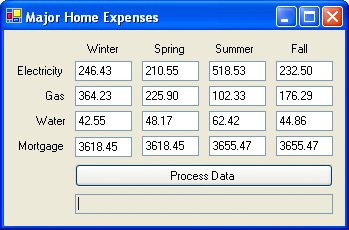
| 1. |
Private Sub btnProcess_Click(...) Handles btnProcess.Click Dim total As Double = 0 For itemNum As Integer = 0 To 3 total += CDbl(txtWinter(itemNum).Text) Next txtBox.Text = "Expenses for winter: " & FormatCurrency(total) End Sub |
| 2. |
Private Sub btnProcess_Click(...) Handles btnProcess.Click Dim total As Double = 0 total += CDbl(txtWinter(2).Text) total += CDbl(txtSpring(2).Text) total += CDbl(txtSummer(2).Text) total += CDbl(txtFall(2).Text) txtBox.Text = "Annual water bill: " & FormatCurrency(total) End Sub |
| 3. |
Private Sub btnProcess_Click(...) Handles btnProcess.Click Dim diff As Double Dim total As Double = 0 For i As Integer = 0 To 3 diff = CDbl(txtSummer(i).Text) - CDbl(txWinter(i).Text) total += diff Next txtBox.Text = "Summer bills top winter bills by " & _ FormatCurrency(total) End Sub |
| 4. |
Private Sub btnProcess_Click(...) Handles btnProcess.Click Dim total As Double = 0 For itemNum As Integer = 0 To 3 total += TotalCateg(itemNum) Next txtBox.Text = "Total major expenses: " & FormatCurrency(total) End Sub |
In Exercises 5 through 8, determine the output displayed when the button is clicked.
| 5. | Structure Appearance Dim height As Double Dim weight As Double End Structure Private Sub btnDisplay_Click(...) Handles btnDisplay.Click Dim person1, person2 As Appearance person1.height = 72 person1.weight = 170 person2.height = 12 * 6 If person1.height = person2.height Then lstOutput.Items.Add("heights are same") End If person2 = person1 lstOutput.Items.Add(person2.weight) End Sub |
| 6. |
Structure TestData Dim name As String Dim score As Double End Structure Dim sr As IO.StreamReader = IO.File.OpenText("SCORES.TXT") Private Sub btnDisplay_Click(...) Handles btnDisplay.Click Dim student As TestData For i As Integer = 1 to 3 GetScore(student) DisplayScore(student) Next sr.Close() End Sub Sub GetScore(ByRef student As TestData) student.name = sr.ReadLine student.score = CDbl(sr.ReadLine) End Sub Sub DisplayScore(ByVal student As testData) lstOutput.Items.Add(student.name & " " & student.score) End Sub (Assume that the six lines of the file SCORES.TXT contain the following data:Joe, 18, Moe, 20, Roe, 25.) |
| 7. |
Structure Address Dim street As String Dim city As String Dim state As String End Structure Structure Citizen Dim name As String Dim residence As Address End Structure Private Sub btnDisplay_Click(...) Handles btnDisplay.Click Dim person As Citizen person.name = "Mr. President" person.residence.street = "1600 Pennsylvania Avenue" person.residence.city = "Washington" person.residence.state = "DC" txtOutput.Text = person.name & " lives in " & _ person.residence.city & ", " & person.residence.state End Sub |
| 8. |
Structure TaxData Dim socSecNum As String Dim numExem As Integer 'Number of exemptions Dim maritalStat As String Dim hourlyWage As Double End Structure Structure Employee Dim name As String Dim hrsWorked As Double Dim taxInfo as TaxData End Structure Private Sub btnDisplay_Click(...) Handles btnDisplay.Click Dim worker as Employee worker.name = "Hannah Jones" worker.hrsWorked = 40 worker.taxInfo.hourlyWage = 20 txtOutput.Text = worker.name " & earned " & _ FormatCurrency(worker.hrsWorked * worker.taxInfo.hourlyWage) End Sub |
In Exercises 9 through 11, determine the errors.
| 9. |
Structure Nobel Dim peace as String Dim year as Integer End Structure Private Sub btnDisplay_Click(...) Handles btnDisplay.Click Dim prize As Nobel peace = "International Atomic Energy Agency" | ||||||||||||||||||||||||||||
| 10. |
Structure Vitamins Dim a As Double Dim b As Double End Structure Private Sub btnDisplay_Click(...) Handles btnDisplay.Click Dim minimum As Vitamins minimum.b = 200 minimum.a = 500 lstOutput.Items.Add(minimum) End Sub | ||||||||||||||||||||||||||||
| 11. |
Structure BallGame Dim hits As Double Dim runs As Double End Structure Private Sub btnDisplay_Click(...) Handles btnDisplay.Click Dim game1, game2 As BallGame game1.hits = 15 game1.runs = 8 game2.hits = 17 game2.runs = 10 If game1 > game2 Then txtOutput.Text = "The first game was better." Else txtOutput.Text = "The second game was at least as good." End If End Sub | ||||||||||||||||||||||||||||
| 12. | Write a line or lines of code as instructed in Steps (a) through (e) to fill in the missing lines in the following program. Structure Appearance Dim height As Double 'Inches Dim weight As Double 'Pounds End Structure Structure Person Dim name As String Dim stats As Appearance End Structure Private Sub btnDisplay_Click(...) Handles btnDisplay.Click Dim person1, person2 As Person (missing lines) End Sub
A campus club has 10 members. The following program stores information about the students into an array of structures. Each structure contains the student's name and a list of the courses he or she is currently taking. Exercises 13 through 16 request that an additional event procedure be written for this program. Structure Student Dim name As String Dim courses() As String End Structure Dim club(9) As Student Private Sub frmStudents_Load(...) Handles MyBase.Load Dim pupil As student 'Enter data for first student pupil.name = "Juan Santana" ReDim pupil.courses(2) pupil.courses(0) = "CMSC 100" pupil.courses(1) = "PHIL 200" pupil.courses(2) = "ENGL 120" club(0) = pupil 'Enter data for second student pupil.name = "Mary Carlson" ReDim pupil.courses(3) pupil.courses(0) = "BIOL 110" pupil.courses(1) = "PHIL 200" pupil.courses(2) = "CMSC 100" pupil.courses(3) = "MATH 220" club(1) = pupil 'Enter names and courses for remaining 8 people in the club End Sub | ||||||||||||||||||||||||||||
| 13. | Write the code for a btnDisplay_Click event procedure that will display the names of all the students in the club in a list box. | ||||||||||||||||||||||||||||
| 14. | Write the code for a btnDisplay_Click event procedure that will display the names of all the students in the club who are registered for three courses. | ||||||||||||||||||||||||||||
| 15. | Write the code for a btnDisplay_Click event procedure that will display the names of all the students in the club who are enrolled in CMSC 100. | ||||||||||||||||||||||||||||
| 16. | Write the code for a btnDisplay_Click event procedure that will display the names of all the students in the club who are not enrolled in CMSC 100. | ||||||||||||||||||||||||||||
| 17. | Write a program to compute a student's grade-point average for a semester. Allow for as many as six courses. For each course, the grades (A, B,...) should be entered in an element of an array of six text boxes, and the semester hours credits entered into another array of six text boxes. After the student fills in the grades and clicks on a button, a Function procedure should compute the GPA. Then a Sub procedure should display the GPA along with one of two messages. A student with a GPA of 3 or more should be informed that he or she has made the honor roll. Otherwise, the student should be congratulated on having completed the semester. | ||||||||||||||||||||||||||||
| 18. | Table 7.1 gives the U.S. Census Bureau projections for the populations (in millions) of the states predicted to be the most populous in the year 2025. Write a program that allows the user to enter the current populations of the states into an array of text boxes, computes the projected population growths for the states in an array of text boxes, and gives the percentage growth for the collection of five states. The growth is calculated with the formula
Percentage growth can be displayed as FormatPercent(growth). Test the program with the current populations shown in Figure 7.4 Figure 7.4. Sample run for Exercise 18. | ||||||||||||||||||||||||||||
| 19. | Write a program to look up data on notable tall buildings. The program should declare a user-defined data type named "Building" with the members "name", "city", "height", and "stories". This interactive program should allow the user to type the name of a building into a text box and then search through an array of structures to determine the city, height, and number of stories of the building when a button is pressed. If the building is not in the array, then the program should so report. Place the information in Table 7.2 into a text file, and read it into the array.
| ||||||||||||||||||||||||||||
| 20. | Given the following flight schedule, write a program to load this information into an array of structures, and ask the user to specify a flight number. Have the computer find the flight number and display the information corresponding to that flight. Account for the case where the user requests a nonexistent flight.
| ||||||||||||||||||||||||||||
| 21. | Table 7.3 contains the names and number of stores of the top 10 pizza chains in 2003. Write a program to place these data into an array of structures, compute the total number of stores for these 10 chains, and display a table giving the name and percentage of total stores for each of the companies.
| ||||||||||||||||||||||||||||
| 22. | A retail store has five bins, numbered 1 to 5, each containing a different commodity. At the beginning of a particular day, each bin contains 45 items. Table 7.4 shows the cost per item for each of the bins and the quantity sold during that day.
Write a program to
| ||||||||||||||||||||||||||||
Solutions to Practice Problems 7.3
| 1. | The event procedure contains two errors. First, the definition of a structure cannot be inside a procedure; it must be typed into the Declarations section of the Code window. Second, the statements Team.school = "Rice" and Team.mascot = "Owls" are not valid. Team.school and Team.mascot are not valid. "Team" should be replaced by a variable of type Team that has previously been declared. |
| 2. | Structure Team Dim school As String Dim mascot As String End Structure Private Sub btnDisplay_Click(...) Handles btnDisplay.Click Dim squad As Team squad.school = "Rice" squad.mascot = "Owls" txtOutput.Text = squad.school & " "& squad.mascot End Sub |
EAN: 2147483647
Pages: 164


